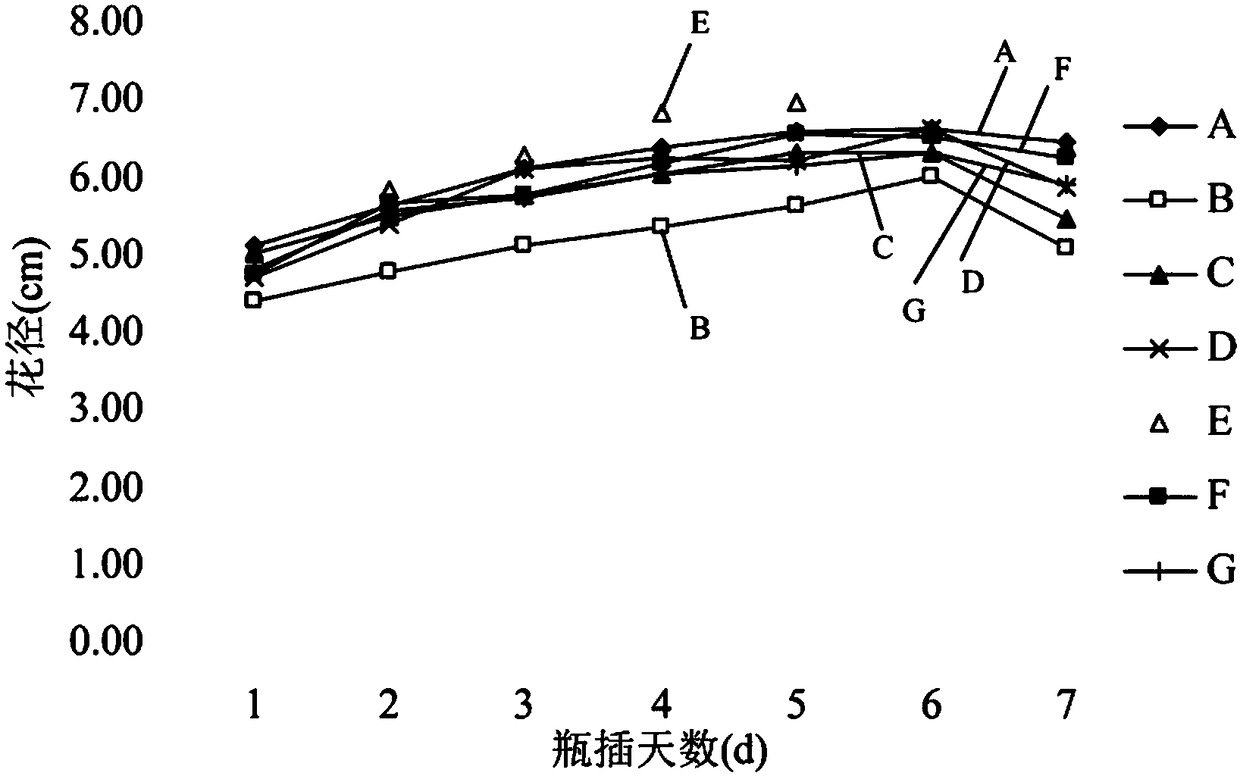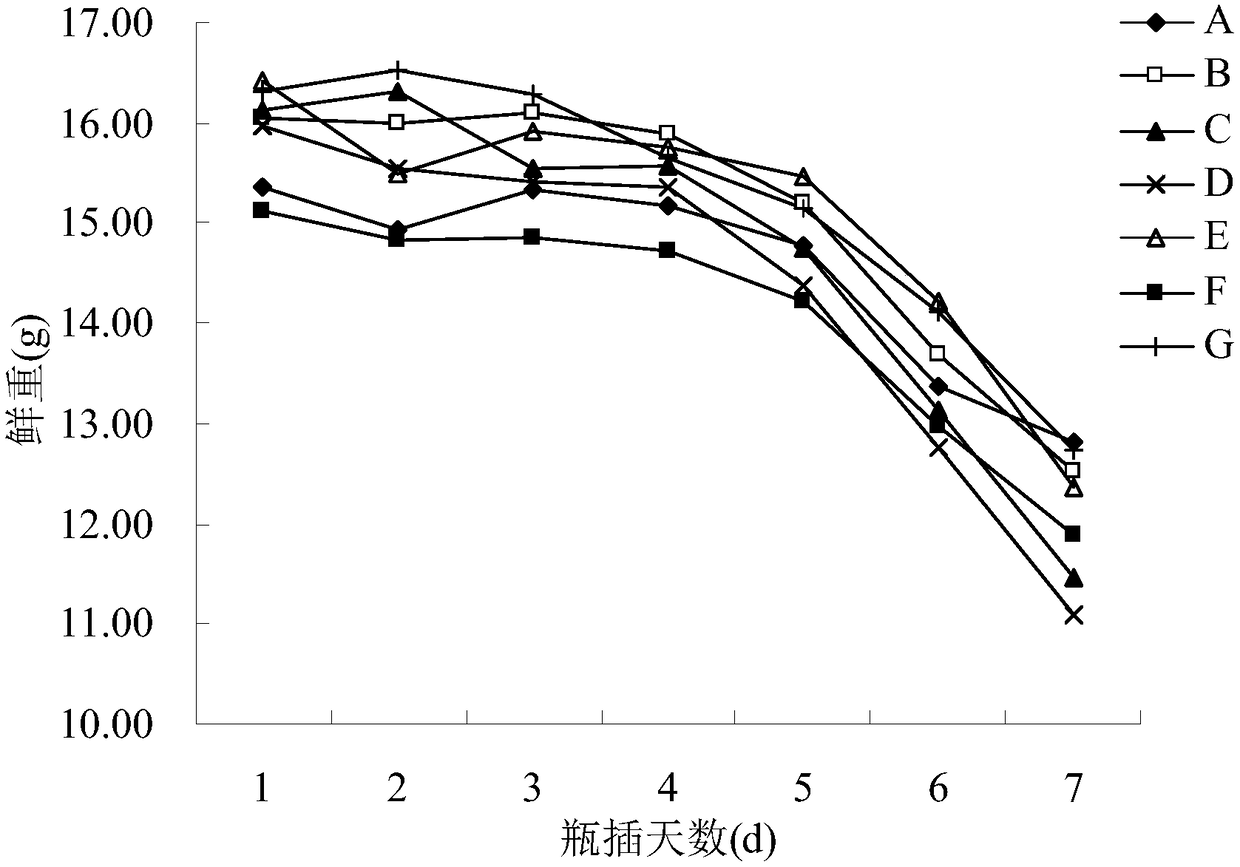Method for prolonging vase life of Chinese rose flowers
A technology of vase and rose, applied in the fields of botanical equipment and methods, preservation and application of plants, can solve the problems of replacing fresh roses, high cost, limited fresh-keeping life of flowers, etc., and achieve the effect of prolonging the fresh-keeping time.
- Summary
- Abstract
- Description
- Claims
- Application Information
AI Technical Summary
Problems solved by technology
Method used
Image
Examples
Embodiment 1
[0032] A method for prolonging the life of rose vases, comprising the following steps:
[0033] S1, material handling
[0034] Prune rose branches before vase insertion, so that the length of the branches is 30cm, and two healthy leaves are reserved on the upper half of the branches. The healthy leaves are not incomplete or yellow; 35°, to get the branches to be inserted, and the 35° angle can make the area of the flower branch absorb the nutrient solution the largest. Place it in a laboratory with no strong light, no wind, and constant room temperature for standby.
[0035] S2, bottle holder
[0036] Insert the branches to be inserted into the bottle containing the nutrient solution, and immerse 1 / 4 of the length of the branches below the liquid surface to complete the rose vase;
[0037] Among them, 1 L of nutrient solution was prepared according to the following method: 30 g of sucrose, 200 mg of 8-HQ, 250 mg of citric acid, 0.3 mg of NAA, 50 mg of salicylic acid, and ...
Embodiment 2
[0039] A method for prolonging the life of rose vases, comprising the following steps:
[0040] S1, the material processing steps are the same as in Example 1;
[0041] S2, bottle holder
[0042] Insert the branches to be inserted into the bottle containing the nutrient solution, and immerse 1 / 3 of the length of the branches below the liquid level to complete the rose vase;
[0043] Among them, 1L of nutrient solution was prepared according to the following method: 30g of sucrose, 200mg of 8-HQ (8-hydroxyquinoline), 250mg of citric acid, 0.3mg of NAA, 50mg of salicylic acid, and dilute water to 1L; The water used in Example 1 was distilled water.
Embodiment 3
[0045] A method for prolonging the life of Chinese rose vases, the steps are basically the same as in Example 1, the difference is that the water used in Example 3 is tap water.
[0046] In order to verify the effect of the present invention, we have carried out following comparative experiment, and the processing mode of each group is as follows:
[0047] Group A: adopt the nutrient solution formula and method of embodiment 1;
[0048] Group B: Nutrient solution was prepared according to the following method: 30 g of sucrose, 200 mg of 8-HQ, 250 mg of citric acid, 10 mg of 6-BA (6-benzylaminopurine), 50 mg of salicylic acid, and dilute water to 1 L; The operation of the method for all the other prolonging the life-span of rose vase is the same as that of embodiment 1.
[0049] Group C: The nutrient solution was prepared according to the following method: 30g of sucrose, 200mg of 8-HQ, 250mg of citric acid, 50mg of GA3 (gibberellin), 50mg of salicylic acid, dilute water to 1L...
PUM
| Property | Measurement | Unit |
|---|---|---|
| Length | aaaaa | aaaaa |
Abstract
Description
Claims
Application Information
 Login to View More
Login to View More - R&D
- Intellectual Property
- Life Sciences
- Materials
- Tech Scout
- Unparalleled Data Quality
- Higher Quality Content
- 60% Fewer Hallucinations
Browse by: Latest US Patents, China's latest patents, Technical Efficacy Thesaurus, Application Domain, Technology Topic, Popular Technical Reports.
© 2025 PatSnap. All rights reserved.Legal|Privacy policy|Modern Slavery Act Transparency Statement|Sitemap|About US| Contact US: help@patsnap.com



